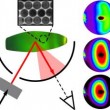Home > Press > Seeing the Light? Making Sense of Disorder in Polymer Opals
 |
Abstract:
The iridescent colours of natural opals have fascinated people for thousands of years. It is interesting, however, that the colours we see are generated only by diffraction of light between the ordered planes of atoms which make up the structures. In order to reproduce this effect in artificial systems and to allow such opal characteristics to be applied to, for example, flexible materials such as clothing or packaging, research into synthetic opals has gained momentum in the last decades.
Seeing the Light? Making Sense of Disorder in Polymer Opals
Germany | Posted on December 7th, 2012The diffraction of light from opal materials is very sensitive to the angle of reflection from the atomic planes within these materials, and variations in these angles can occur as a result of defects within the crystal structure. In order to fully characterize and understand the optical properties of synthesized opals it is important to be able to completely measure this angle-dependence; however, previously a technique to do this has been lacking.
Now, Andrew I. Haines and Jeremy J. Baumberg et al. have described a new way of measuring the three-dimensional angular scattering of light from nanostructures (hyperspectral goniometry technique), and use it to show that scattering from polymer opals, composed of ordered polymer nanospheres, is anisotropic. Specifically, light is scattered more broadly in the direction perpendicular to sample processing. They find that this effect is the result of chain defects, i.e., the presence of extra lines of polymer nanospheres, in the polymer-opal films tested; and that the enhanced colour observed when the structures are more highly ordered is due to an increased effective refractive-index contrast.
Furthermore, by doping these synthetic opal structures with light-absorbing carbon nanoparticles they discovered the colour saturation could be greatly improved as the nanoparticles absorb multiply scattered light so lower the background scattering without affecting the resonant scattering.
This research was reported in Advanced Optical Materials, a new section in Advanced Materials dedicated to breakthrough discoveries and fundamental research in photonics, plasmonics, metamaterials, and more, covering all aspects of light-matter interactions. Advanced Optical Materials will start as an independent journal in 2013. More information can be found on www.advopticalmat.de
####
For more information, please click here
Copyright © Wiley-VCH Materials Science Journals
If you have a comment, please Contact us.Issuers of news releases, not 7th Wave, Inc. or Nanotechnology Now, are solely responsible for the accuracy of the content.
| Related Links |
![]() Link to the original paper on Wiley Online Library:
Link to the original paper on Wiley Online Library:
| Related News Press |
News and information
![]() Simulating magnetization in a Heisenberg quantum spin chain April 5th, 2024
Simulating magnetization in a Heisenberg quantum spin chain April 5th, 2024
![]() NRL charters Navy’s quantum inertial navigation path to reduce drift April 5th, 2024
NRL charters Navy’s quantum inertial navigation path to reduce drift April 5th, 2024
![]() Discovery points path to flash-like memory for storing qubits: Rice find could hasten development of nonvolatile quantum memory April 5th, 2024
Discovery points path to flash-like memory for storing qubits: Rice find could hasten development of nonvolatile quantum memory April 5th, 2024
Discoveries
![]() Chemical reactions can scramble quantum information as well as black holes April 5th, 2024
Chemical reactions can scramble quantum information as well as black holes April 5th, 2024
![]() New micromaterial releases nanoparticles that selectively destroy cancer cells April 5th, 2024
New micromaterial releases nanoparticles that selectively destroy cancer cells April 5th, 2024
![]() Utilizing palladium for addressing contact issues of buried oxide thin film transistors April 5th, 2024
Utilizing palladium for addressing contact issues of buried oxide thin film transistors April 5th, 2024
Announcements
![]() NRL charters Navy’s quantum inertial navigation path to reduce drift April 5th, 2024
NRL charters Navy’s quantum inertial navigation path to reduce drift April 5th, 2024
![]() Discovery points path to flash-like memory for storing qubits: Rice find could hasten development of nonvolatile quantum memory April 5th, 2024
Discovery points path to flash-like memory for storing qubits: Rice find could hasten development of nonvolatile quantum memory April 5th, 2024
Textiles/Clothing
![]() Protective equipment with graphene nanotubes meets the strictest ESD safety standards March 25th, 2022
Protective equipment with graphene nanotubes meets the strictest ESD safety standards March 25th, 2022
![]() Polymer fibers with graphene nanotubes make it possible to heat hard-to-reach, complex-shaped items February 11th, 2022
Polymer fibers with graphene nanotubes make it possible to heat hard-to-reach, complex-shaped items February 11th, 2022
![]() Flexible material shows potential for use in fabrics to heat, cool July 3rd, 2020
Flexible material shows potential for use in fabrics to heat, cool July 3rd, 2020
Photonics/Optics/Lasers
![]() With VECSELs towards the quantum internet Fraunhofer: IAF achieves record output power with VECSEL for quantum frequency converters April 5th, 2024
With VECSELs towards the quantum internet Fraunhofer: IAF achieves record output power with VECSEL for quantum frequency converters April 5th, 2024
![]() Nanoscale CL thermometry with lanthanide-doped heavy-metal oxide in TEM March 8th, 2024
Nanoscale CL thermometry with lanthanide-doped heavy-metal oxide in TEM March 8th, 2024
![]() Optically trapped quantum droplets of light can bind together to form macroscopic complexes March 8th, 2024
Optically trapped quantum droplets of light can bind together to form macroscopic complexes March 8th, 2024
![]() HKUST researchers develop new integration technique for efficient coupling of III-V and silicon February 16th, 2024
HKUST researchers develop new integration technique for efficient coupling of III-V and silicon February 16th, 2024
|
|
||
|
|
||
| The latest news from around the world, FREE | ||
|
|
||
|
|
||
| Premium Products | ||
|
|
||
|
Only the news you want to read!
Learn More |
||
|
|
||
|
Full-service, expert consulting
Learn More |
||
|
|
||








